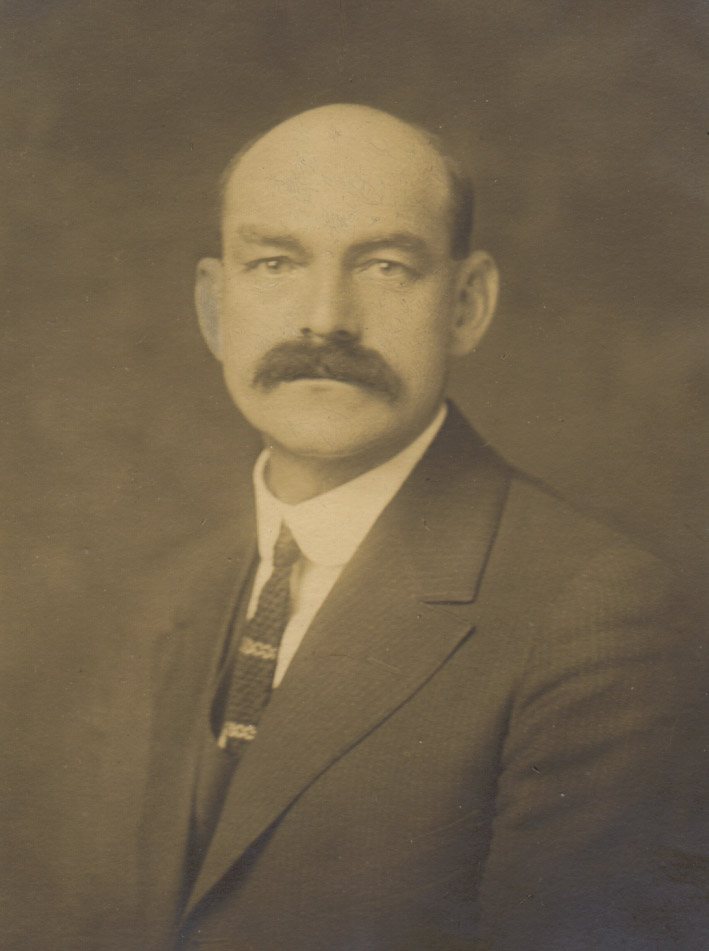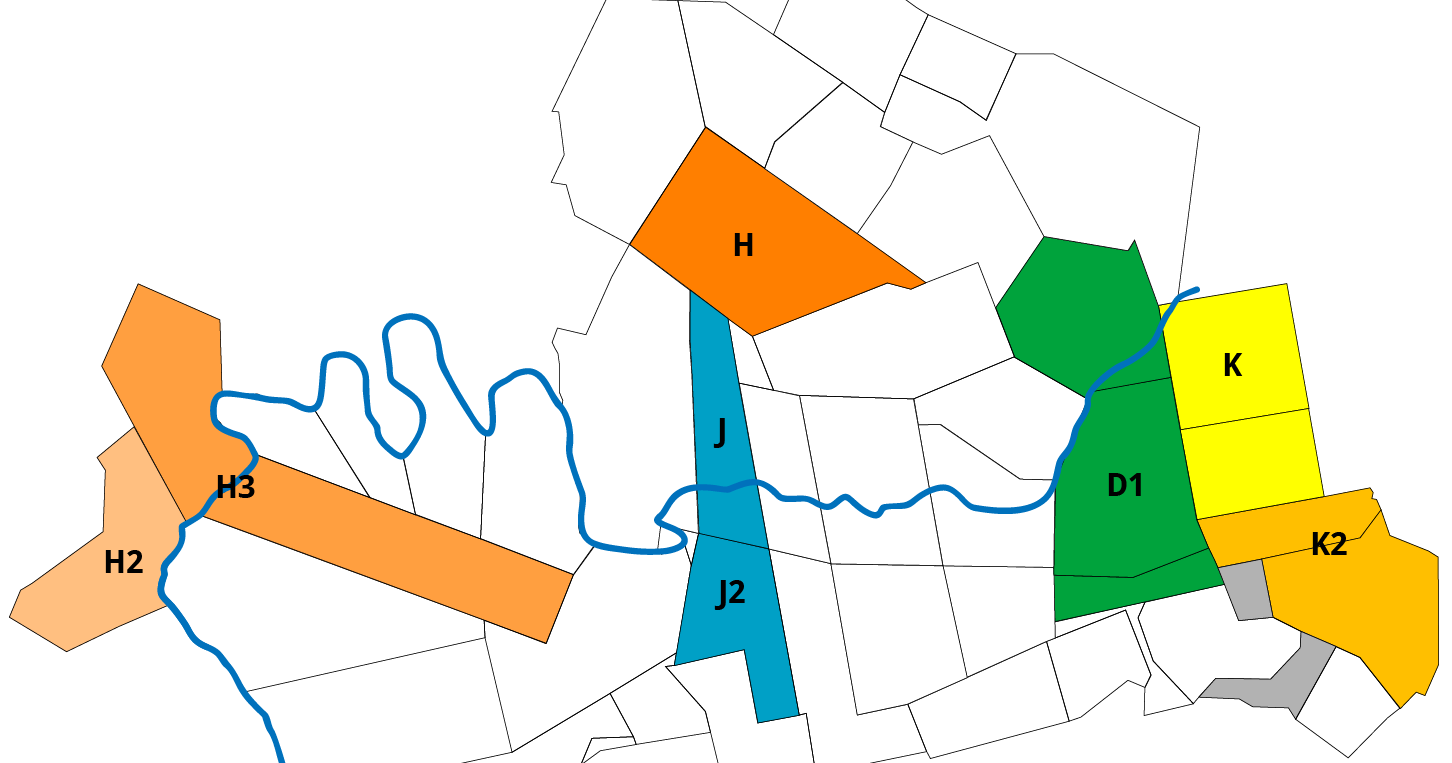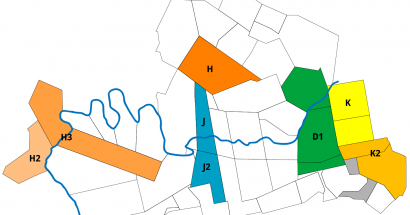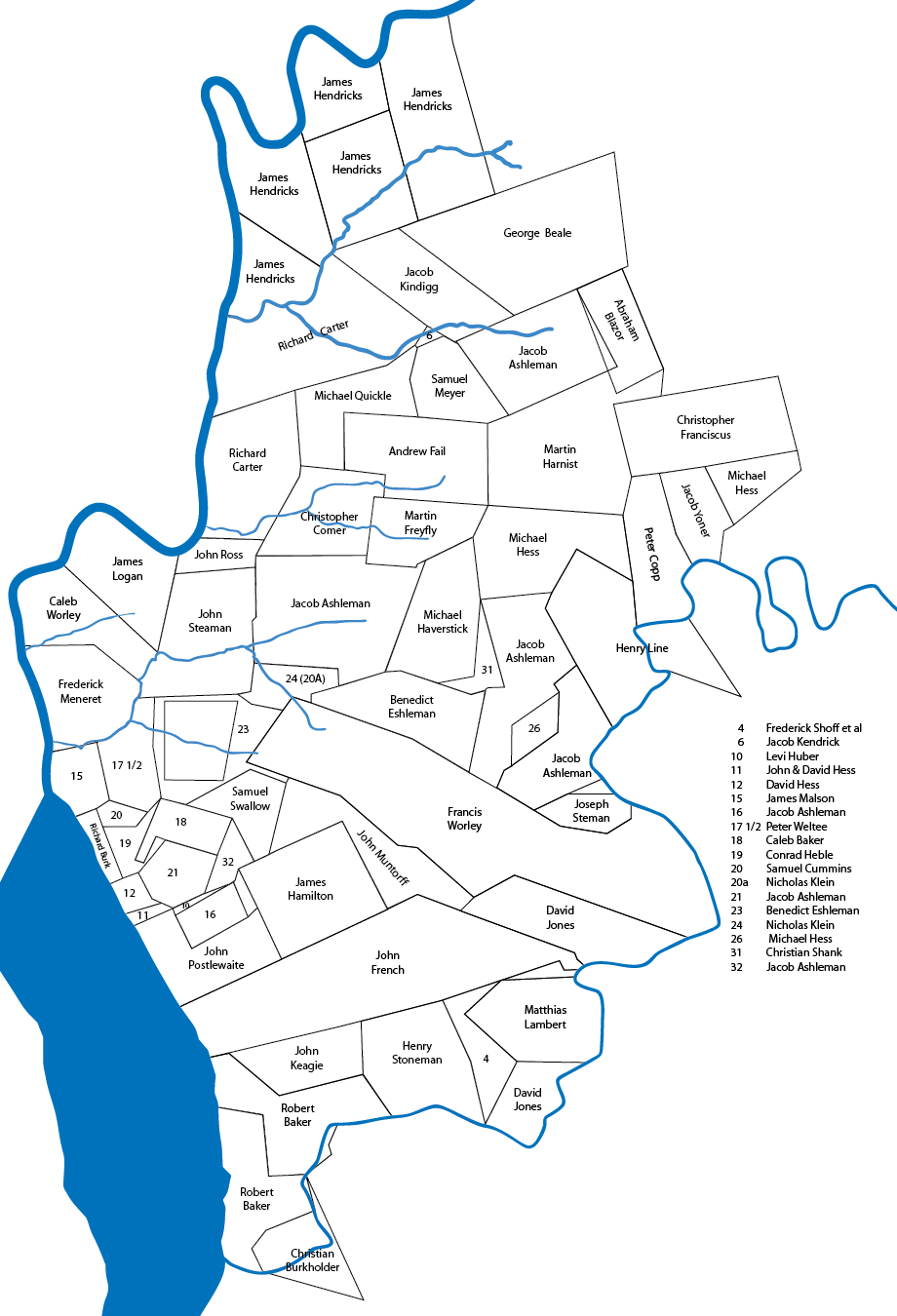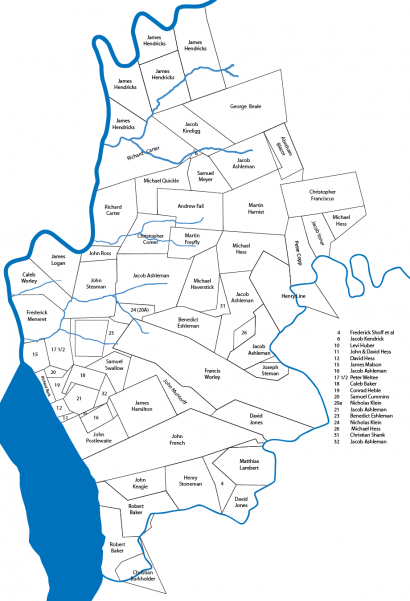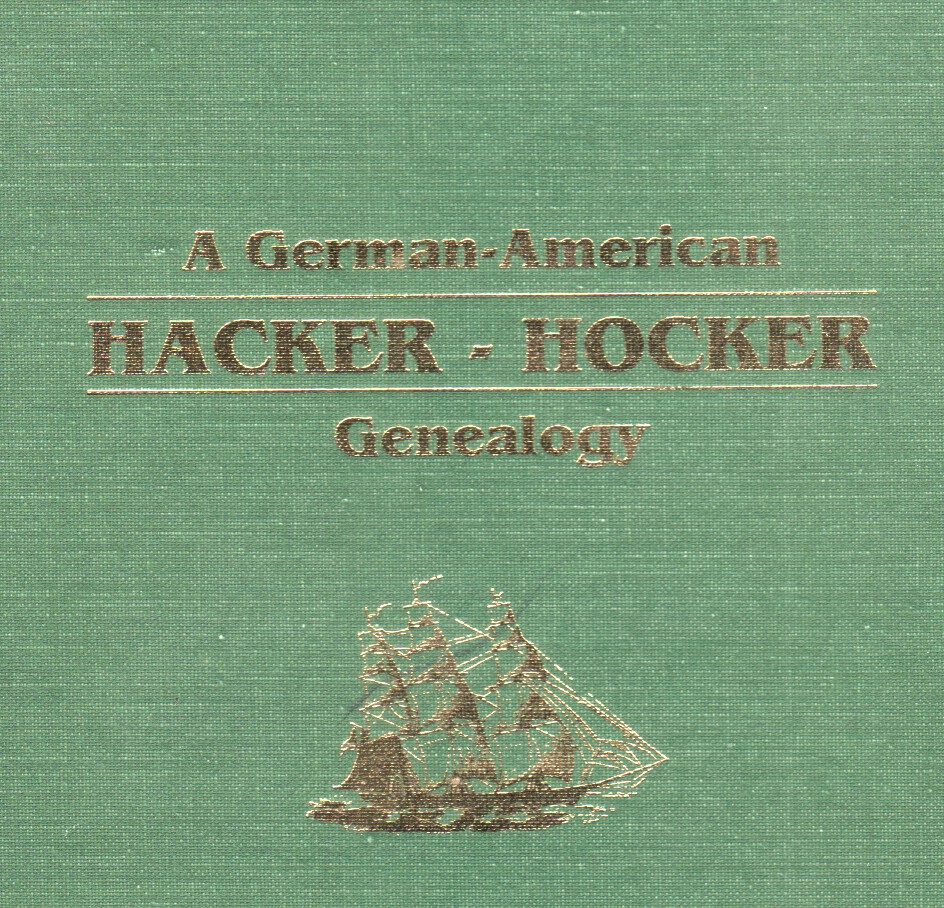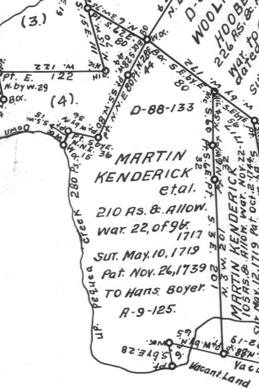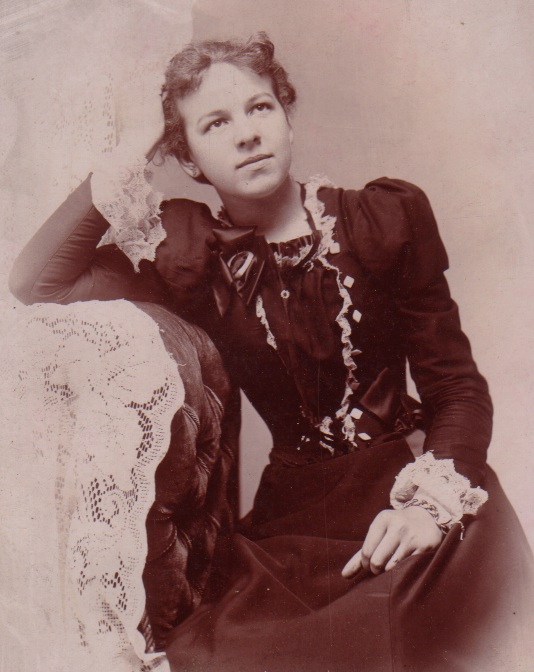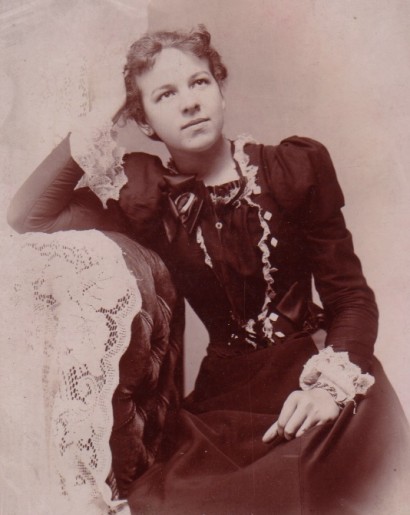On 26 June 1781, Henry Fetter married Christina Hacker, daughter of Hans Adam and Maria Elisabetha (Weidman) Hacker, at Christ Lutheran Church in Stouchsburg, Berks County, Pennsylvania. Bill Wingeard in his A German-American Hacker-Hocker Genealogy names Henry as the son of Bernhard and Gertrude (___) Fetter. Unfortunately, he doesn’t provide a source for that information.
In rewriting the genealogy, I’ve been trying to identify and make sense of the contemporary Fetter/Fehder/Feather/Vetter/Vehders living in the Warwick and Cocalico township in the late 1700s. There are at least two Henry Fetters that I need to clarify in the source data that I’ve found. Since writing about my research helps me to clarify my thoughts and findings, here goes.
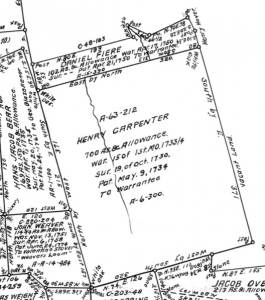
Henry Carpenter 700-acre tract in Warwick (now Clay) & Cocalico townships
On 13 May 1759, William and Salome (Wister) Chancellor sold 95 1/2 acres in Cocalico Township to Henry Feather. It adjoined land that had been or was to be granted to Bernhard Feather. This 95 acres was part of a larger tract of 350 acres that Henry Carpenter had sold to his grand-daughter Salome Wister on 21 November 1743. This tract included 32 acres that Daniel Fiere had sold Salome Wister on 12 June 1750. The tract the Chancellors sold adjoined land of “Henry Stouffer,” placing it on the north-eastern portion of the two tracts shown in the map (see Henry Carpenter’s 700 acres).
I did not find a deed record of Bernhard Fetter’s purchase, but both he and Henry took out mortgages on their properties—both 95 1/2 acres—on 1 Jun 1759. Bernhard’s wife’s name is recorded as Gertraut. Henry’s wife’s name is recorded as Anna Maria.
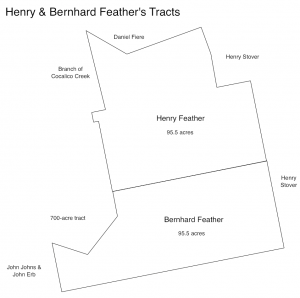
Bernhard & Henry Feather tracts, Cocalico Township
Bernhard is listed in Warwick tax records as “Berned Feter” in 1754. There is also a “Leard Fether” in Warwick in 1751. Bernhard is listed in 1769 in Cocalico and in 1770 in Warwick with the note “& a place in Cocalico.” Two Henry Feather’s are listed in Cocalico in 1770, as is a Conrad Feather. One Henry Feather is listed as “a single man with his father.” The other Henry’s listing indicates that he was listed as “Fetter” in 1769.
Additional tax records list Bernhard Fetter in Warwick Township in 1771, 1772, and 1773. In 1779, a “Fetter, Geo & Henry” are listed instead of Bernhard. It’s possible (maybe even probable) that these were Bernhard’s sons. Meanwhile, a Henry Feather is listed as a freeman (unmarried) in Cocalico Township in 1771, 1772, and taxed on 90 acres in 1773 and 40 acres in 1779.
An inventory is listed for Bernhard Feather of Warwick Township in 1777 in the Archive Collections at the Lancaster County Historical Society. So, depending on the actual date of the inventory, Bernhard died in late 1776 or 1777. A will abstract is online for Gertraut Feather of Warwick Township. It indicates her will was written on 22 December 1792 and filed on 19 June 1794. It only names one child: Elizabeth, wife of John Frymyer.
Henry and Anna Mary Fetter of Cocalico Township sold 95.5 acres to Henry and Peter Fetter on 24 May 1773. These were likely their sons. They likely also had a son named Bernhard. A will abstract of Bernhard Feather of Cocalico Township in 1816 names his brother Peter and his nieces as: Susanna Brubaker, Christiana, Elizabeth Schlebach (wife of Henry), Mary Klingaman (wife of Michael). A deed naming appraisers for the lands of Henry Feder of Cocalico Township in 1822 names the same women as his daughters, plus Susanna Henly, a widow and only daughter of Henry’s son, Henry [III?].
Given that Henry and Bernhard Fetter purchased land in 1759, they would have to have been born at or before 1738 (≥21 years of age). Because he was listed in tax records in 1754, Bernhard was likely born prior to 1733. Henry [Jr.] and Peter Fetter would have been born at or before 1752 (≥ 21 years of age in 1773). One of the two Henry Fetters listed in Cocalico Township tax records in 1770 was likely recently of age. The other at least a couple of years older.
Henry and Christina (Ernst) Vetter had a daughter Susanna, born 31 January 1774, baptized in Reiher’s Reformed Church on 9 January 1774. I believe this Henry Vetter is Henry Jr., the son of Henry and Anna Maria (___) Fetter. Henry and Christina had two other children baptized at Reiher’s Reformed Church: John Henry, born 10 March 1776, baptized 5 Apr 1776 and Samuel, born 6 November 1777, baptized 21 December 1777. Susanna’s birth places the marriage of Henry and Christina (Ernst) Fetter about 1772. That would place Henry’s birth about 1751, possibly a few years earlier. This fits perfectly with a child of Henry and Anna Maria (___) Fetter and the Henry Fetter taxed in Cocalico Township in 1771—1773.
The 1822 deed naming appraisers for the land Henry Fetter left his daughters also names a widowed daughter of his son. What’s interesting about her is the fact that her guardian, Isaac Erb, is also named in the document. This indicates that although she was a widow, she was not yet 21 years of age. Therefore, she was born about 1802, maybe a few years later. That is certainly consistent with a father who was born in the 1770s or very early 1780s.
Which of these Henry Fetters married Christina Hacker, daughter of Hans Adam and Elisabetha (Weidman) Hacker? Until I can find the means to distinguish between the various men of this name, I won’t be able to accurately document Henry and Christina (Hacker) Fetter. I’ve got a start in gathering data, but I believe I need more information on these families—if I can get it—to truly be able to identify them in the records. If you have information on any of these families, please leave a comment!

